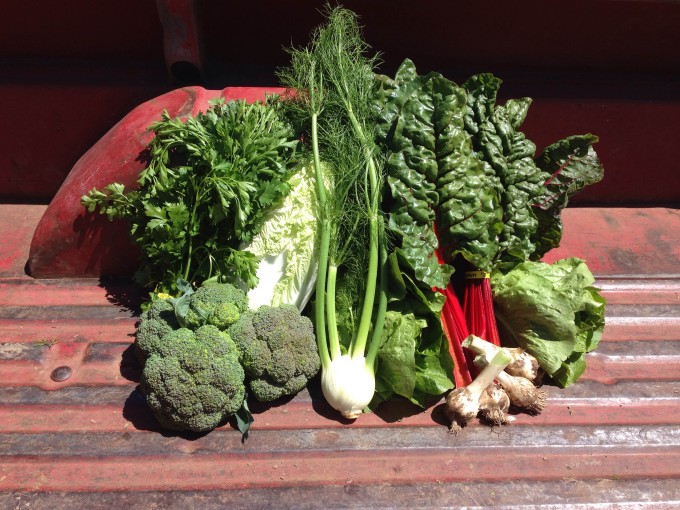The farm is bursting with life! Just recently we saw a doe with her fawn foraging near our cover crop fields, find plenty of frogs, and enjoy the company of many Barn Swallows on the farm. These beautiful and playful little birds sometimes fly circles around the tractors, trucks, and people walking up and down the roadways. Tiny as they are, they breed and spend the summer in North America and then migrate all the way to Central and South America for the winter! They feed mid-flight on small insects and build nests out of mud and grass, almost exclusively on man-made structures. Our morning meetings are often punctuated by plenty of Barn Swallow chirping as they perch on the barns nearby. This year, we are lucky enough to have a nest just outside our office door that a pair built this spring.
birds sometimes fly circles around the tractors, trucks, and people walking up and down the roadways. Tiny as they are, they breed and spend the summer in North America and then migrate all the way to Central and South America for the winter! They feed mid-flight on small insects and build nests out of mud and grass, almost exclusively on man-made structures. Our morning meetings are often punctuated by plenty of Barn Swallow chirping as they perch on the barns nearby. This year, we are lucky enough to have a nest just outside our office door that a pair built this spring.
Your Share This Week:
- Broccoli
- Cabbage: Napa
- Chard
- Fennel
- Garlic
- Lettuce: Romaine
- Parsley
Cabbage, Napa: We grew some of the largest Napa Cabbages we’ve seen this spring. If you’re worried about how you will ever eat all of this Napa Cabbage in time, fear not…it stores incredibly well in the refrigerator. If wrapped in a plastic bag, you can easily store it for several weeks with minimal change in quality. Just peel off a few leaves as needed, or half/quarter it and re-wrap the remaining portion. Napa Cabbage is great raw, cooked, and fermented as the base ingredient of kimchi.
Chard: We like a variety called ‘Ruby Chard’ with dark glossy leaves and deep red stems. Chard is in the same family as spinach, beets, and quinoa. Despite its name, Swiss Chard is not in fact native to Switzerland. Its thought that a Swiss botanist bestowed Swiss Chard with its botanical name, but it actually hails from the Mediterranean where it has a longstanding history dating back to the days of the Greek and Roman empires. Chard ranks very high along with spinach as being a nutritional superfood; its one of nature’s best sources of vitamin K. The stems are edible as well, just chop them separately and begin cooking slightly ahead of the greens.
Garlic: You will notice that the garlic in your share is smaller than in previous weeks. We are experiencing ‘rust’ in our garlic field, which has motivated us to harvest some of the garlic sooner than we normally would. Rust is a very common fungal infection on garlic in the Pacific Northwest, likely due to our high humidity and precipitation. Rust looks exactly like what its name indicates, and with enough rust, leaves can turn yellow and die- making it difficult to impossible for the plant to reach full size and maturity. We are harvesting our garlic crop early this year as a preventative measure to reduce the likelihood that it will spread to neighboring shallot and onion fields. Rust does not affect the edibility of the garlic.
On-Farm Research
 yielding very promising results with kohlrabi and a few other items. The clubroot causing organism named Plasmodiophora brassicae mainly affects the Brassica family (broccoli, cabbage, radishes, kale, turnips, etc) severely stunting plant growth resulting in greatly decreased harvest yields.The resting spores of this very weird organism can stay dormant in the soil for up to 20 years just waiting for a brassica plant’s root to make contact. Two years ago we lost half an acre of broccoli to this disease. So now to prevent out breaks we add lime to our greenhouse soil mix, give each field a minimum of 3 years (ideally 5 to 7 years) rest from brassica family crops prior to subsequent plantings, never seed brassica family cover crops, and apply lime directly to transplants’ root zones to increase soil pH to 6.8 (ideally 7.0 to 7.2). As you can see we look forward to continuing to work with OSU and hope for some statistically relevant results to help us continue to find ways to manage this disease.
yielding very promising results with kohlrabi and a few other items. The clubroot causing organism named Plasmodiophora brassicae mainly affects the Brassica family (broccoli, cabbage, radishes, kale, turnips, etc) severely stunting plant growth resulting in greatly decreased harvest yields.The resting spores of this very weird organism can stay dormant in the soil for up to 20 years just waiting for a brassica plant’s root to make contact. Two years ago we lost half an acre of broccoli to this disease. So now to prevent out breaks we add lime to our greenhouse soil mix, give each field a minimum of 3 years (ideally 5 to 7 years) rest from brassica family crops prior to subsequent plantings, never seed brassica family cover crops, and apply lime directly to transplants’ root zones to increase soil pH to 6.8 (ideally 7.0 to 7.2). As you can see we look forward to continuing to work with OSU and hope for some statistically relevant results to help us continue to find ways to manage this disease.

